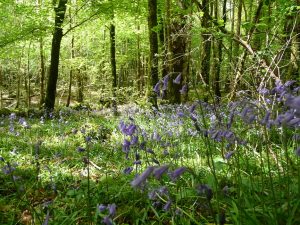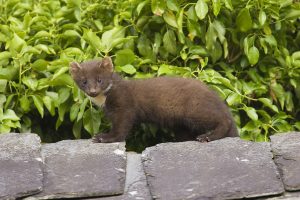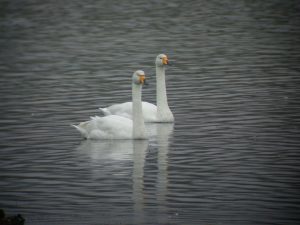The Waters Of Coole
Coole Park is part of the Coole-Garryland Complex Special Area of Conservation (site code SAC 252), which is situated in a low-lying karstic limestone area west of Gort, County Galway. It contains a series of seasonal lakes ( turloughs), which are fed by springs and a partly submerged river, surrounded by woodland, pasture and limestone heath. The more well-known turloughs present in the site include Lydacan, Crannagh North, Raheen, Crannagh South, Coole, Garryland, Newtown and Hawkhill.
Turloughs are listed as priority habitat on Annex I of the European Union Habitats Directive, and the turloughs at Coole-Garryland are particularly good examples of this habitat type. Vegetation of the turloughs includes Shoreweed (Littorella uniflora), Spike-rush (Eleocharis palustris), Water-purslane (Lythrum portula) and Fen Violet (Viola persicifolia). A species of Starwort (Callitriche palustris) has recently been recorded from the site, its only known station in Ireland. The Coole river itself is of particular interest for the occurrence of a rare riverine habitat characterised by Trifid Bur-marigold (Bidens tripartita), Red Goosefoot (Chenopodium rubrum) and species of Knotgrass (Polygonum spp.).
The turloughs are fringed by a range of habitats on limestone pavement, including scrub communities containing Buckthorn (Rhamnus catharticus) and Hawthorn (Crataegus monogyna). In places, heath communities have developed over the limestone pavement, consisting of Ling Heather (Calluna vulgaris), Juniper (Juniperus communis), Blue Moor-grass (Sesleria albicans) and occasional Yew (Taxus baccata). In addition, the site contains good examples of smooth pavement and associated species-rich grasslands. Small areas of orchid-rich grassland occur at Coole-Garryland. The colourful array of orchids which can be found here include Pyramidal Orchid (Anacamptis pyramidalis), Spotted Orchids (Dactylorhiza spp.), Fragrant Orchid (Gymnadenia conopsea), Fly Orchid (Ophrys insectifera) and Greater Butterfly Orchid (Platanthera chlorantha).
I turned about and looked
where branches break
The glittering reaches of the flooded lake.”
– W.B.Yeats ‘Coole Park & Ballylee’, 1931
There are two other turloughs in the vicinity of Coole : Garryland turlough is to the west of Coole, and Newtown turlough is situated to the south just outside the Reserve. All of these are classed among the best examples of their kind, and are of international importance
The Woods Of Coole
A remarkable feature of the turloughs at Coole Park is that they are closely associated with areas of woodland. Although substantial parts of the original deciduous forest have been converted to coniferous woodland composed of non-native species, stands of semi-natural deciduous woodland survive. Pedunculate Oak (Quercus robur) and Ash (Fraxinus excelsior) are the dominant species on deeper, more fertile soils, where there is also some Hazel (Corylus avellana), occasional Yew (Taxus baccata) and Elm (Ulmus spp.). There are also some unusual areas of dwarf Pedunculate Oak woodland growing on limestone pavement. This species of oak does not typically colonise this type of substrate.
 Some of the deciduous woodlands have a mixture of native and non-native species. These mixed woodlands have a diverse shrub layer comprised of Spindle (Euonymus europaeus), Privet (Ligustrum vulgare), Burnet Rose (Rosa pimpinellifolia), Guelder Rose (Viburnum opulus), Blackthorn (Prunus spinosa), Pear (Pyrus pyraster) and Honeysuckle (Lonicera periclymenum). The ground flora is rich and includes Wood Anemone (Anemone nemorosa), Dog Violet (Viola riviniana), Shining Crane’s-bill (Geranium lucidum), Maidenhair Spleenwort (Asplenium trichomanes), Northern Bedstraw (Galium boreale), Biting Stonecrop (Sedum acre), Harebell (Campanula rotundifolia) and Bitter Vetch (Lathyrus montanus). The woodlands are notable for the presence of rare species of Myxomycete fungi, namely, Licea idris, Licea marginata and Macbrideola decapillata, the first-named in one of only three known sites for the species.
Some of the deciduous woodlands have a mixture of native and non-native species. These mixed woodlands have a diverse shrub layer comprised of Spindle (Euonymus europaeus), Privet (Ligustrum vulgare), Burnet Rose (Rosa pimpinellifolia), Guelder Rose (Viburnum opulus), Blackthorn (Prunus spinosa), Pear (Pyrus pyraster) and Honeysuckle (Lonicera periclymenum). The ground flora is rich and includes Wood Anemone (Anemone nemorosa), Dog Violet (Viola riviniana), Shining Crane’s-bill (Geranium lucidum), Maidenhair Spleenwort (Asplenium trichomanes), Northern Bedstraw (Galium boreale), Biting Stonecrop (Sedum acre), Harebell (Campanula rotundifolia) and Bitter Vetch (Lathyrus montanus). The woodlands are notable for the presence of rare species of Myxomycete fungi, namely, Licea idris, Licea marginata and Macbrideola decapillata, the first-named in one of only three known sites for the species.
The complex of habitats at Coole-Garryland provides habitat for a variety of mammal species, including Otter and Pine Marten. The Otter is listed on Annex II of the EU Habitats Directive, while Pine Marten is considered to be threatened in Europe. The Coole-Garryland complex is also home to one of the most important and unique assemblages of insects in the country, including several notable species of beetles and flies.

Because of Yeats, the woods at Coole are known by name to people all over the world. Yeats refers several times to the ‘Seven Woods of Coole’ ; in fact there are more than seven. The woods were greatly loved and cared for by the Gregorys, and every grove and plantation had its carefully chosen name. Most were named for some local topographical feature, but some were called after people, e.g. the Isabella Wood.
The woods at Coole are not wildwood, areas of natural woodland that show little human interference. They are managed woods, parts of which have their origins in the natural woodland cover which can still be found in odd corners, especially on the far side of the lake. Their natural character has been overlain by forestry practice that extends back for upwards of 200 years.
All the native tree species will be found in the woods at Coole, side by side with introduced species, of which Beech is the most abundant, occuring nearly everywhere. The most famous of all these trees at Coole is a Copper Beech, for this is the species to which the Autograph Tree in the garden belongs. Another famous tree, Lady Gregory’s favourite of all the trees at Coole – a Catalpa tree (Catalpa bignonioides), can still be seen just inside the entrance to the garden. It is now wind-thrown and prostrate, but in its day it would have been a magnificent tree, especially in flower. In 1995 Lady Gregory’s grand-daughters planted a replacement Catalpa at this site.
The turlough system at Coole-Garryland is considered to be the most diverse in the country, for both its physiography and vegetation. It is unique in that it is so closely associated with woodland. The juxtaposition of these two distinct habitats, in addition to the presence of a variety of turloughs, has led to the development of uncommon communities, and rare species of insects and plants occur which are associated with both the turloughs and the turlough/woodland transition. Overall, the range of good quality habitats at Coole-Garryland supports a high diversity of plant and animal species, rendering this site of prime importance for conservation.
The Birds Of Coole

Coole/Garryland is also designated a Special Protection Area (site code SPA 107) for birds under the EU 1979 Birds Directive. This is mainly due to its importance for wintering waterfowl, especially Whooper Swan (mean peak of 324 in 1995/96 – 98/99), Bewick’s Swan (79 in winter 96/97), Wigeon (mean peak of 1044 in 1995/96 – 98/99), Mallard (mean peak of 330 in 1995/96 – 98/99), Pochard (mean peak of 176 in winter 1995/96 – 98/99), along with smaller numbers of Teal, Tufted Duck, Lapwing, Curlew and Dunlin. In 1996 seven pairs of Lapwing bred at Newtown Turlough and two pairs of Common Sandpiper bred at Coole Lough.
The woods at Coole are also very attractive habitat for birds in general. The trees themselves provide territorial song posts and nesting sites as well as roosting places in winter. Beneath the trees there is a great variety of seed-bearing plants and shrubs which provide food for the birds. In summer the woodland birds have an additional food supply in the insects that appear. The various bird species tend to feed at different levels in the woodland layers and thus they avoid competing with each other for food. Birds commonly found in the woods include larger species such as Wood Pigeons, Sparrowhawks and Jays, which are easily identified from their size, flight pattern and calls. Smaller species commonly seen include Robins, Blackbirds, Song Thrushes, Wrens, Dunnocks as well as members of the finch and tit families and summer visitors such as the Chiffchaffs and Willow Warblers.



